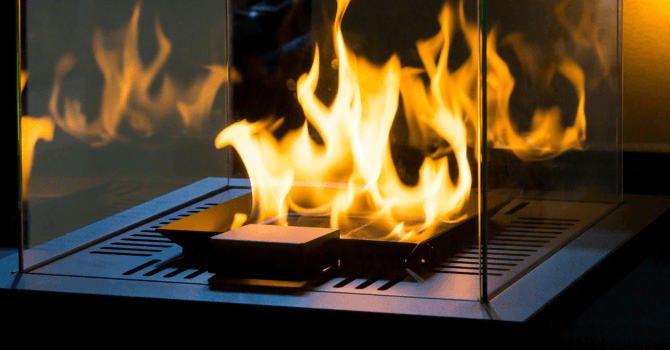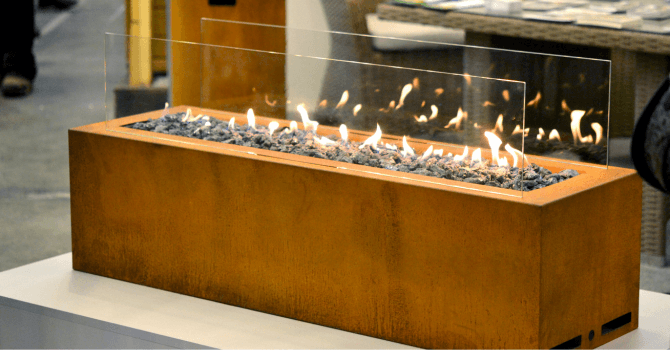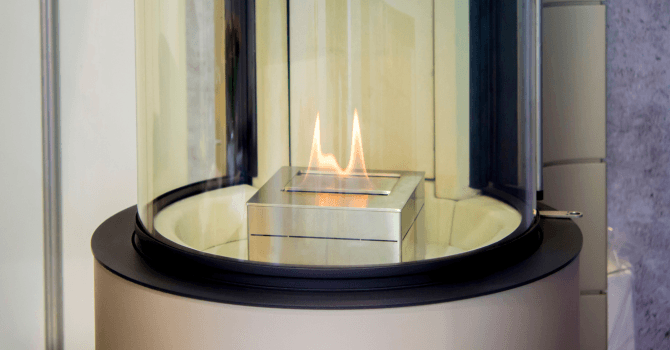Ethanol Fireplace - An Aesthetic and Odourless Option
By Editorial Team
Updated on November 15, 2024
Ethanol fireplaces are increasingly sought-after, making for an aesthetic and odourless solution to create a warm ambiance. Unlike conventional fireplaces, such units don’t need a chimney or direct vent, streamlining their installation. Smoke-free, chimneyless, nothing but a gentle warmth inside your home. This article will focus on the benefits of ethanol fireplaces. Amongst all the different types of fireplaces out there, “Ethanol fireplaces are best suited for ambiance purposes,” states Stéphanie Ouimet, an Eco-Feu representative.
Keep reading for more information and pointers by Ouimet, guiding you through this article and detailing all there is to know about ethanol fireplaces.
How Do Ethanol Fireplaces Work, and Are They Any Good?

Source: Canva
An ethanol fireplace runs on denatured ethyl alcohol, commonly referred to as ethanol. To ignite the fuel, simply pour ethanol into the burner, then light it. Once lit, the fireplace will spark a real, smoke-free flame, one that mainly releases small amounts of carbon dioxide (CO₂) and water vapour.
Ethanol fireplaces come in different sizes, such as tabletop or freestanding fireplaces, wall-mounted models, and portable devices, each suited to different rooms and purposes. However, as Ouimet mentions, “An ethanol fireplace is primarily designed for ambiance purposes, rather than serving as a main source of heat.” Also, note that a bioethanol fireplace fuel consumption depends on the size of its burner and the flame’s intensity, burning on average 0.5–1 litre of ethanol per hour.
There are a lot more noteworthy aspects to consider about the workings of ethanol fireplaces, including indoor air pollution and fire hazards.
What Is the Recommended Room Size for an Ethanol Fireplace?
Without an air exchange system to match the gas output generated by burning ethanol in a fireplace, this sort of product must be installed in a room with at least 200 square feet of space per 1,000 BTU produced.
Indeed, the primary characteristic of an ethanol-burning fireplace is that it doesn’t require a smoke exhaust system. Basically, only heat and CO₂ are produced.
However, the reality is that ethanol is typically made with denaturing agents and additives, which release the following during combustion:
VOCs
Formaldehyde
Polycyclic aromatic hydrocarbons (PAHs)
Other gases are also produced by ethanol in gel form, such as acrolein, resulting from the gelling agent’s combustion.
Hence, we highly encourage you to heed the following pointer provided by Ouimet, Eco-Feu, “When filling up this sort of fireplace, we highly recommend using a liquid ethanol gel over other products.”
What Type of Burner Should You Use?
There are two types of burners used to ignite ethanol in a fireplace:
Manual
Automatic
Some fireplace models are designed with either a manual or automatic burner, but most are manufactured with just one option.
Manual Burner
Manual burners have several advantages:
Cheaper
Don’t run on a power source
Can be positioned just about anywhere in the house
Automatic Burner
Automatic burners also have several advantages:
Feature built-in safety sensors
Doesn’t need to be filled with ethanol before every use
Can be controlled remotely using a remote or mobile app for smart homes
The Different Types of Modern Ethanol Fireplaces: Freestanding, Portable, Built-In

Source: Canva
There are two main types of ethanol fireplaces, which can be distinguished as such:
Exterior Tabletop Fireplace
This is a freestanding unit, spanning roughly 51 ¼ inches, 10 ¼ inches across, and 16 11/16 inches tall.
Equipped with a manual burner, they’re considered portable fireplaces; they can be placed anywhere and everywhere, but bear in mind fireplace safety wherever in use.
Wall-Mounted Interior Fireplace - Does It Give Off Much Heat?
There are two types of wall-mounted fireplaces:
Wall-mount
Built-in
No matter the case, wall-mounted fireplaces feature an automatic burner and are easily powered via a wall outlet.
However, among the characteristics to focus on, turn your attention to CO₂ emissions. The most modern ethanol fireplaces emit a quantity of carbon dioxide matching that of a human.
Depending on the burner’s size, 1,200 ml of ethanol suffices to guarantee a 3–5-hour autonomy, whereas bigger fireplaces will run for 4 hours on a 3.65-litre ethanol supply.
Liquid Fuels

Source: Canva
As mentioned at the beginning of the article, burning ethanol releases gases, the number and quantity of which vary based on the composition of the product used.
The only issue is that, as of now, there are no standards by which to comply to manage the composition of liquid fuels. However, the Underwriters Laboratories of Canada (ULC) has already edited a certification and labelled some of these fuels.
Prioritize ULC-certified liquid fuels, and look into their composition. Typically, contents will include:
Ethyl alcohol
Isopropyl alcohol
Ethyl acetate
Water
Some liquid fuels are issued from lignocellulosic ethanol waste materials, in other words, paper. The manufacturing process limits greenhouse gas emissions and actively limits the use of natural resources.
Bioethanol is also available for resale. Its advantage? Made from starch and sugar in a plant-based blend, and in such a way that it won't interfere with the food chain.
Ethanol Fireplace Maintenance Tips

Source: Canva
Tip 1: How to clean an ethanol fireplace
Using a water-soaked cloth and all-purpose cleaner, wipe the insides of the panel and the frame.
Run a dry cloth along the sides to wipe off any water residue or spots.
For wood panels, use wood oil. Dampen a cloth with the product and run it over the panel to wipe it clean.
Caution! Make sure the fireplace is turned off and cold to the touch before proceeding.
Tip 2: Wipe off soot and dirt
Soot and dirt build up in two areas:
On the burner
Inside the burner
Use a damp paper towel to wipe off the soot and dirt coating the burner. Note that harsh products can deteriorate the material. When in doubt, refer to the manufacturer’s instruction manual.
Using a vacuum to clean inside the burner will work just fine.
Tip 3: How to polish a burner
To clean the burner, use a gentle cloth or rag to wipe off soot and dirt. Ouimet recommends “Prioritizing mild cleaners, avoiding tough chemical products that can damage the burner.”
To avoid scratching the burner, always clean it with the stainless steel grain, ensuring water or the cleaning product doesn’t leak inside the burner. So, use paper towels to wipe off products on the burner.
Finish by wiping the burner with a damp cloth.
Ethanol Fireplace: Basic Safety Rules to Consider
Although ethanol fireplaces are typically safe, their use still mandates a few precautionary measures to prevent fire hazards and preserve air quality.
Installation: Fireplaces must be installed according to local safety standards, such as standard ULC/ORD-C627.1-2008, and according to the manufacturer’s instructions.
Use: Never fill up the burner when the fireplace is turned on or still warm to the touch, doing so could trigger a fire. According to Ouimet, Eco-Feu, it’s always best to wait until the burner is cold before refilling it.
Ventilation: Use the fireplace in a well-ventilated area and follow government-issued recommendations, such as installing a carbon monoxide detector in rooms with an ethanol fireplace.
Ethanol storage: Ethanol must be stored in a safe location, away from all sources of heat and out of children’s reach to prevent accidents.
Maintenance: Regular care and upkeep is necessary to maintain the look and proper workings of the fireplace.
An Aesthetic and Practical Solution with Basic Safety Rules
Ethanol fireplaces make for a practical option to benefit from a gentle warmth and fireside vibe without the constraints of traditional fireplaces. Their easy installation and elegant design make it the perfect solution for modern decor enthusiasts. However, it’s important to use them safely by scrupulously complying with the safety warnings issued by the manufacturer and considering government recommendations, such as those issued by your local fire station and building authorities. Before installing an ethanol fireplace, check your local regulations and contact your home insurance provider to ensure a safe and compliant installation and use.
Check out our article about clean burning fireplaces.
FAQ About Indoor and Outdoor Ethanol Fireplaces
Can an ethanol fireplace be used as a heating source?
Yes, if it ranges between 1–3 kilowatts. For comparison's sake, a wood-burning fireplace generates roughly 6 kilowatts of heat, inching up to 13.3 kilowatts, depending on the unit installed.
How can you avoid fire hazards using a bioethanol fuel fireplace?
An ethanol fireplace should never be refilled with liquid fuel when:
Powered on
Burning
Warm to the touch
If so, you risk setting your living room aflame.
“Ethanol fireplaces may be banned from certain condo towers in cities like Montréal,” states Ouimet. Also, your insurance provider may request that you have a small, hand-held fire extinguisher nearby and install at least one carbon monoxide detector.
*All quotes featured in this article were translated into English by Reno Quotes.
Looking for something else?
Related articles
The latest industry news, interviews, technologies, and resources.

Editorial Team
•07 Nov 2023
Picking a material for the bathroom floor can be a unique choice in comparison with other flooring materials around your home. Once you have determined the main aspects of selecting a floor, including the look, feel, durability and cost, you must consider the most important factor: a material that can deal with an excess of humidity and water.

Équipe éditoriale
•07 Nov 2023
If you’re living under a roof where privacy is a privilege, you might be thinking about how you can section off the rooms of your home to make them more intimate. Building a non-bearing interior wall can add an element of separation and independence to even the most open of spaces. This project requires basic carpentry skills, as well as tools to go along with them.

Karine Dutemple
•07 Nov 2023
For some reason, your garage may lose its primary purpose. And because it would be a shame to waste that extra space, why not transform your garage to give it a new life?
Editorial Team
•23 Jul 2025
Whether it’s getting ready in the morning before leaving for work or treating yourself to some well-deserved R&R at the end of a long day, the bathroom is a space where one spends a considerable amount of time. And that’s why a bathroom that’s been hit hard by the passage of time can quickly become a nuisance, both in terms of function and aesthetics. Fortunately, the latest bathroom design trends can help turn your space into a modern and calming retreat.
